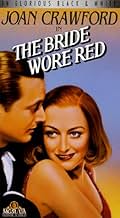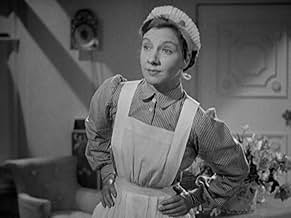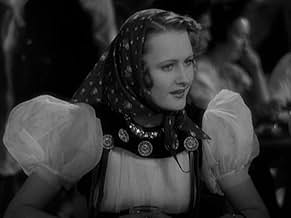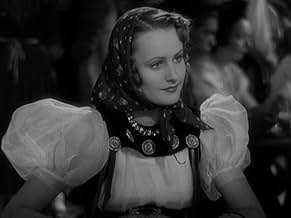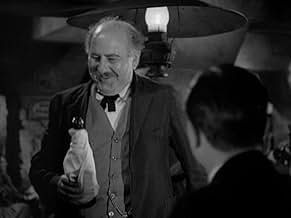CALIFICACIÓN DE IMDb
6.3/10
1.3 k
TU CALIFICACIÓN
Agrega una trama en tu idiomaA lounge singer is sent by a count to pose as a wealthy socialite.A lounge singer is sent by a count to pose as a wealthy socialite.A lounge singer is sent by a count to pose as a wealthy socialite.
- Dirección
- Guionistas
- Elenco
Mary Philips
- Maria
- (as Mary Phillips)
Rafael Alcayde
- Hotel Clerk
- (sin créditos)
Nino Bellini
- Cosmos Club Waiter
- (sin créditos)
Agostino Borgato
- Cordellera Bar Waiter
- (sin créditos)
Adriana Caselotti
- First Peasant Girl
- (sin créditos)
Robert Cauterio
- Hotel Clerk
- (sin créditos)
Irene Coleman
- Cosmos Club Hat Check Girl
- (sin créditos)
Gino Corrado
- Cosmos Club Croupier
- (sin créditos)
Opiniones destacadas
The plot may not be a novel one, but the title was appetising and so were the cast. 'The Bride Wore Red' was seen as part of one of many completest quests (seeing as many films not yet seen of the person in question as possible), this one being for Joan Crawford. As well as Crawford, we have other talented performers in Franchot Tone, Robert Young, George Zucco and Billie Burke. All of whom are great when with good material and in the right roles.
Although 'The Bride Wore Red' is not among the best of all involved (all have also been far worse served) or one of the best of the genre, it is still well worth watching and has a lot of positive traits. It didn't deserve to be a flop. As far as Crawford's 30s films go, which were a mixed lot in quality, 'The Bride Wore Red' somewhere around solid middle, and anybody that loves romance and comedy individually and together are likely to (not guaranteed as not everybody has the same tastes for everything) find a lot to enjoy. The case with me.
Is 'The Bride Wore Red' perfect? No. The story, despite the premise actually being good, has few surprises and can be very silly with some suspension of disbelief needed at times later on. Also felt that the start was on the dull side but once the main plot kicks in properly there is a lot more energy.
Do agree that Anni's conflict with what she wants and what she has to give up could have gone into more detail, that could have been a fascinating angle and added so much to Anni's character and given her more heart.
Crawford, looking stunning, however gives it her all without over-acting to the point of overbalancing the rest of the cast or film. She doesn't phone it in either once the plot gets going, despite being on the cold side at the beginning. Tone has one of the more likeable characters and is charming and suave. Young has some of the more juicier lines and brings a nice edge and sophistication to them. Zucco is convincingly decadent and Burke is in an atypically shrews viper sort of role and plays it to the hilt.
Found the script to be amusingly droll and that it did sparkle. The story wasn't perfect but it had energy and charm and the chemistry between the cast was beautifully pitched, the three leads work more than convincingly together. 'The Bride Wore Red' looks great, especially Crawford's wardrobe and the luminous photography. Franz Waxman's score is sumptuous without being too loud or melodramatic. Dorothy Azner's direction is a bit bland and slow to begin with, but becomes more assured as the film goes along.
Summing up, nice enough if not mind-blowing. 7/10
Although 'The Bride Wore Red' is not among the best of all involved (all have also been far worse served) or one of the best of the genre, it is still well worth watching and has a lot of positive traits. It didn't deserve to be a flop. As far as Crawford's 30s films go, which were a mixed lot in quality, 'The Bride Wore Red' somewhere around solid middle, and anybody that loves romance and comedy individually and together are likely to (not guaranteed as not everybody has the same tastes for everything) find a lot to enjoy. The case with me.
Is 'The Bride Wore Red' perfect? No. The story, despite the premise actually being good, has few surprises and can be very silly with some suspension of disbelief needed at times later on. Also felt that the start was on the dull side but once the main plot kicks in properly there is a lot more energy.
Do agree that Anni's conflict with what she wants and what she has to give up could have gone into more detail, that could have been a fascinating angle and added so much to Anni's character and given her more heart.
Crawford, looking stunning, however gives it her all without over-acting to the point of overbalancing the rest of the cast or film. She doesn't phone it in either once the plot gets going, despite being on the cold side at the beginning. Tone has one of the more likeable characters and is charming and suave. Young has some of the more juicier lines and brings a nice edge and sophistication to them. Zucco is convincingly decadent and Burke is in an atypically shrews viper sort of role and plays it to the hilt.
Found the script to be amusingly droll and that it did sparkle. The story wasn't perfect but it had energy and charm and the chemistry between the cast was beautifully pitched, the three leads work more than convincingly together. 'The Bride Wore Red' looks great, especially Crawford's wardrobe and the luminous photography. Franz Waxman's score is sumptuous without being too loud or melodramatic. Dorothy Azner's direction is a bit bland and slow to begin with, but becomes more assured as the film goes along.
Summing up, nice enough if not mind-blowing. 7/10
Dorothy Arzner is the director of this film, and though she does not make a lot of films, she usually makes rather substantial ones. This is certainly a substantial one.
The most appealing aspect of this production is the chemistry and loveliness of the couple played on screen by Joan Crawford and Franchot Tone (married in real life). This is not the only film that MGM has costarred them in together, but in this picture, it is easy to see the magic they create.
For his part, Robert Young is a worthy costar. And so is Joan's dazzling dress, referenced in the title. One must not forget to mention the always splendid Billie Burke, directed in several other pictures by Arzner. This time she portrays a real shrew, not her trademark scatterbrained character.
The most appealing aspect of this production is the chemistry and loveliness of the couple played on screen by Joan Crawford and Franchot Tone (married in real life). This is not the only film that MGM has costarred them in together, but in this picture, it is easy to see the magic they create.
For his part, Robert Young is a worthy costar. And so is Joan's dazzling dress, referenced in the title. One must not forget to mention the always splendid Billie Burke, directed in several other pictures by Arzner. This time she portrays a real shrew, not her trademark scatterbrained character.
Joan Crawford stars in "The Bride Wore Red," a 1937 MGM film based on the play by Ferenc Molnar. Here, it's directed by Dorothy Arzner. Arzner was a fascinating woman - a female director amid a sea of men - very much ahead of her time in her dress, profession, and lifestyle, and highly intelligent. Was she a great director? Hard for me to say. I don't think she always got the best scripts. And in Crawford, she had a headstrong star as well.
The story concerns a poor girl, Anni (Crawford) who sings in a sleazy café (read: with prostitution as a sideline)in the red light district of Trieste. A count she meets believes that the only thing separating the rich from the poor is money - it's not class, it's not breeding, it's not education. To make his point, he sends Anni to a fabulous resort with beautiful new clothes for two weeks. Anni meets Rudi (Robert Young), from an excellent and wealthy family, but he's engaged. With time short, Anni decides that it's Rudi she wants, and is determined to stick it out as long as necessary to get him. But it's not only a lack of funds and Rudi's fiancé standing in her way - it's also the postman, Giulio (Franchot Tone).
Crawford is beautiful, and this was the type of role she played continuously in the 1930s with great success. Tone, Young, and Billie Burke give her good support.
What is this business with the "no European accents" that someone mentioned? Actors do not use European accents when portraying foreigners in their own country or a nearby country. The characters aren't speaking English with a foreign accent in Poland, Switzerland, or Italy. They're speaking another language. If accents were necessary, all Chekov plays would be done with Russian accents. They aren't.
I thought for what this was, the film took a little too long to make its point and was a bit slow in spots. It's not the best Crawford film, but she gives a strong performance as a willful woman determined to marry money. As for Arzner's direction, apparently she couldn't get anywhere with Crawford, so I'll withhold judgment.
The story concerns a poor girl, Anni (Crawford) who sings in a sleazy café (read: with prostitution as a sideline)in the red light district of Trieste. A count she meets believes that the only thing separating the rich from the poor is money - it's not class, it's not breeding, it's not education. To make his point, he sends Anni to a fabulous resort with beautiful new clothes for two weeks. Anni meets Rudi (Robert Young), from an excellent and wealthy family, but he's engaged. With time short, Anni decides that it's Rudi she wants, and is determined to stick it out as long as necessary to get him. But it's not only a lack of funds and Rudi's fiancé standing in her way - it's also the postman, Giulio (Franchot Tone).
Crawford is beautiful, and this was the type of role she played continuously in the 1930s with great success. Tone, Young, and Billie Burke give her good support.
What is this business with the "no European accents" that someone mentioned? Actors do not use European accents when portraying foreigners in their own country or a nearby country. The characters aren't speaking English with a foreign accent in Poland, Switzerland, or Italy. They're speaking another language. If accents were necessary, all Chekov plays would be done with Russian accents. They aren't.
I thought for what this was, the film took a little too long to make its point and was a bit slow in spots. It's not the best Crawford film, but she gives a strong performance as a willful woman determined to marry money. As for Arzner's direction, apparently she couldn't get anywhere with Crawford, so I'll withhold judgment.
I had high hopes for this one. The plot sounded good. Eccentric Count Armalia (George Zucco) believes that luck of birth is all that separates the rich from the poor. To prove his point, he sets up dive singer Anni (Joan Crawford) as a fake socialite to fool his rich friends. This works but snobbish Robert Young falls for her and wants to marry her. Anni sees the chance to get out of poverty by marrying a rich guy but, at the same time, she has started to fall for poor Franchot Tone. So it becomes a question of whether Anni will choose love or money. Glossy MGM soaper with a nice cast but somehow just misses the mark. It was nice seeing George Zucco in a different kind of role. Also Billie Burke is sort of evil, which is interesting. See it for the cast or out of curiosity. You might enjoy it more than me.
The Bride Wore Red is a ridiculous but fun film. A drunken count, slumming it for the night, runs into a cynical and hungry young woman, Anni Pavlovitch (Joan Crawford). He decides to send her on a luxury vacation to prove his drunken point that the poor and the rich aren't so different after all and buys her new clothes and arranges for her to stay in a luxury resort. Anni, who obviously thinks the whole thing is crazy, decides to go threw with it anyway. Arriving in the alps she meets Giulio (Crawford's real life husband, Franchot Tone) a very pert mail employee who immediately takes a shine to her. The two have sparks aplenty, but when she arrives at the hotel Anni quickly realizes that she would rather always have food on her table than the love of a good man, and quickly sets about seducing Rudi, a flighty engaged man who is very taken with her.
As with most romcoms the real test is if the chemistry works and here it does perfectly. Crawford and Tone have excellent chemistry here and he is very sweet and naive, persistently wearing down the jaded and bitter singer.
It's a lovely sweet film.
As with most romcoms the real test is if the chemistry works and here it does perfectly. Crawford and Tone have excellent chemistry here and he is very sweet and naive, persistently wearing down the jaded and bitter singer.
It's a lovely sweet film.
¿Sabías que…?
- TriviaDuring filming, an electrician fell from the catwalk high above the set, narrowly missing the film's star, Joan Crawford. Shooting was temporarily halted while the man was rushed to hospital. Crawford refused to resume production until she was assured that the man would be fully cared for, that he would remain on salary, and that his family would be provided for. Crawford also called the hospital each day afterwards for reports on his condition.
- Citas
Rudolph 'Rudi' Pal: In my opinion, most people prefer sardines to caviar because most people haven't tried caviar.
- Créditos curiososDuring the opening credits, a music box is shown playing a tune in the background.
- ConexionesFeatured in The Romance of Celluloid (1937)
- Bandas sonorasWho Wants Love?
(1937)
Music by Franz Waxman
Lyrics by Gus Kahn
Sung by Joan Crawford (uncredited) at the Cordellera Bar
Played throughout as part of the score
Selecciones populares
Inicia sesión para calificar y agrega a la lista de videos para obtener recomendaciones personalizadas
- How long is The Bride Wore Red?Con tecnología de Alexa
Detalles
- Fecha de lanzamiento
- País de origen
- Idioma
- También se conoce como
- Once There Was a Lady
- Locaciones de filmación
- Austria(Alpine exteriors)
- Productora
- Ver más créditos de la compañía en IMDbPro
Taquilla
- Presupuesto
- USD 960,000 (estimado)
- Tiempo de ejecución1 hora 43 minutos
- Color
- Relación de aspecto
- 1.37 : 1
Contribuir a esta página
Sugiere una edición o agrega el contenido que falta

Principales brechas de datos
By what name was The Bride Wore Red (1937) officially released in Canada in English?
Responda

